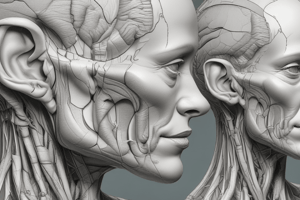Podcast
Questions and Answers
What is the main function of the outer ear?
What is the main function of the outer ear?
- To transmit sound waves to the inner ear
- To amplify sound waves
- To convert sound waves into electrical signals
- To collect sound waves and direct them into the ear canal (correct)
What is the approximate length of the ear canal?
What is the approximate length of the ear canal?
- 5 cm
- 2.5 cm (correct)
- 10 cm
- 1 cm
What is the function of the eardrum?
What is the function of the eardrum?
- To convert sound waves into electrical signals
- To transmit sound waves to the middle ear
- To amplify sound waves
- To vibrate from sound waves, transmitting sound to the middle ear (correct)
What is the function of the ossicles in the middle ear?
What is the function of the ossicles in the middle ear?
What is the main function of the cochlea?
What is the main function of the cochlea?
What is the function of the auditory nerve?
What is the function of the auditory nerve?
What is the main function of the auditory system?
What is the main function of the auditory system?
What is the role of hair cells in the cochlea?
What is the role of hair cells in the cochlea?
Flashcards are hidden until you start studying
Study Notes
Ear Anatomy
- Outer Ear (Pinna or Auricle)
- Collects sound waves
- Directs sound waves into the ear canal
- Made of cartilage and skin
- Ear Canal (External Auditory Meatus)
- Tube that connects the outer ear to the eardrum
- Lined with wax-producing glands and hair follicles
- Approximately 2.5 cm long
- Eardrum (Tympanic Membrane)
- Thin, transparent membrane that separates the ear canal from the middle ear
- Vibrates from sound waves, transmitting sound to the middle ear
- Middle Ear
- Air-filled cavity containing three small bones (ossicles):
- Malleus (hammer)
- Incus (anvil)
- Stapes (stirrup)
- Ossicles amplify sound vibrations, transmitting them to the inner ear
- Air-filled cavity containing three small bones (ossicles):
- Inner Ear
- Contains the cochlea and vestibular system
- Responsible for sound processing and balance
Auditory System
- Sound Transmission
- Sound waves enter the ear canal and strike the eardrum
- Vibrations from the eardrum are transmitted through the ossicles to the inner ear
- The cochlea converts vibrations into electrical signals
- Cochlea
- Spiral-shaped structure in the inner ear
- Divided into three fluid-filled compartments:
- Scala vestibuli (perilymph)
- Scala media (endolymph)
- Scala tympani (perilymph)
- Hair cells in the cochlea convert vibrations into electrical signals
- Auditory Nerve
- Carries electrical signals from the cochlea to the brain
- Interprets sound signals as sound
- Sound Processing
- The brain processes sound information, including:
- Pitch
- Loudness
- Location
- Sound source identification
- The brain processes sound information, including:
Ear Anatomy
- The outer ear (pinna or auricle) collects sound waves and directs them into the ear canal.
- The ear canal is a 2.5 cm long tube that connects the outer ear to the eardrum, lined with wax-producing glands and hair follicles.
- The eardrum is a thin, transparent membrane that separates the ear canal from the middle ear and vibrates from sound waves.
- The middle ear is an air-filled cavity containing three small bones (ossicles): malleus (hammer), incus (anvil), and stapes (stirrup) that amplify sound vibrations.
- The inner ear contains the cochlea and vestibular system, responsible for sound processing and balance.
Auditory System
- Sound transmission occurs when sound waves enter the ear canal, strike the eardrum, and vibrations are transmitted through the ossicles to the inner ear.
- The cochlea is a spiral-shaped structure in the inner ear, divided into three fluid-filled compartments: scala vestibuli (perilymph), scala media (endolymph), and scala tympani (perilymph).
- Hair cells in the cochlea convert vibrations into electrical signals.
- The auditory nerve carries electrical signals from the cochlea to the brain, interpreting sound signals as sound.
- Sound processing in the brain includes identifying pitch, loudness, location, and sound source.
Studying That Suits You
Use AI to generate personalized quizzes and flashcards to suit your learning preferences.




